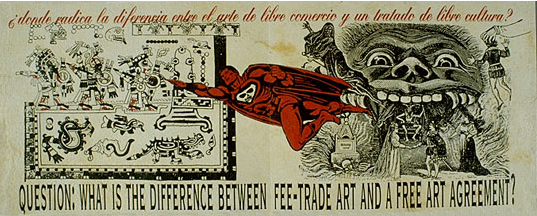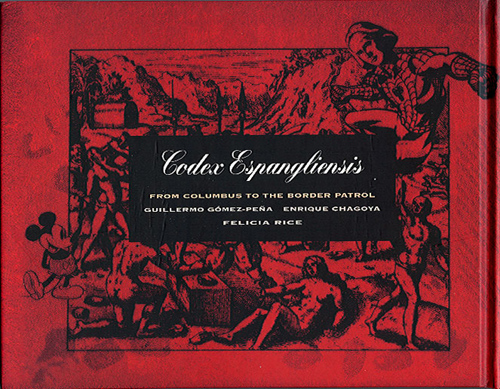Long ago when we were young (the weekend before last, to be exact), Melissa and I took in a truly wonderful art exhibit and a very interesting play.
The exhibit, Borderlandia, at UC Berkeley’s museum of modern art, featured the works of Enrique Chagoya.

Chagoya’s works are explicitly political, dealing with themes of immigration and post-9/11 civil rights, and mix images drawn from indigenous and popular cultural in busy, complicated ways. We saw three distinct types of pieces at the show: large-scale painitngs, etchings drawing on Goya’s The Disasters of War (also on exhibit in the same museum), and codices.
My favorites were the codices: accordion-fold books that “read” from right to left.

This is a small picture. The actual pages are about 7″ x 10″. Imagine unfolding a book like this and spreading it out until it reaches its full length of six-to-ten feet.
And the images on each page have this sort of complexity:

We’ve got Mayan text, a modern-day super hero, a Goya-esque mouth of hell, and politically challenging questions in both Spanish and English.
You can see why Melissa and I want to return to this exhibit a few more times. The richness of Chagoya’s thinking—and, as a result, of his art—can’t be absorbed in a single viewing.
Most of his codices are one-of-a-kind and far beyond our means, but we were able to purchase a copy of the Codex Espangliensis: from Columbus to the Border Patrol, a for-publication project assembled by book artist Felicia Rice, using images by Chagoya and text Guillermo Gómez-Peña.

We’ve already spent one lovely evening looking through this book together and expect to enjoy many more.
Coming up next: Part II, featuring Orson Welles’ Moby Dick Rehearsed.

cool!!